Unraveling the World of Mutual Funds and ETFs: A Beginner’s Guide
When you want to get rich, mutual funds and exchange-traded funds (ETFs) are two of the best and most popular ways to spread out your investments. There are some similarities between them, but it’s important to know the differences between them so you can make an informed choice that fits your financial goals.
Mutual Funds: The Classic Path to Diversification
What They Are: People have used mutual funds as their main investment choice for more than one hundred years. These funds take money from many investors and put it in a wide range of stocks, bonds, and other assets. They’re known for being easy to use and reaching a wide range of areas.
Entry Requirements: Mutual funds usually need a bigger initial payment. One example is that entry points can range anywhere from a few hundred to a few thousand dollars, based on the type of fund and the company that offers it.
Active Management: Active management is a key part of many mutual funds. In order to beat the market, professional managers decide which securities to buy and sell within the fund. Because of the extensive research and strategic trading that goes into this hands-on method, the fees are usually higher.
Trading Mechanism: Mutual funds, on the other hand, are only traded once a day, after the markets stop. The value of an object at the end of the trading day is called its net asset value (NAV). This is what you pay or get.
Types of Mutual Funds:
- Open-Ended Funds: People most often use this type, which lets them buy and sell shares directly with the fund. You can buy as many shares as you want, and each share’s value is changed every day to match the NAV.
- Closed-End Funds: When these funds go public for the first time (IPO), they issue a certain number of shares that can be bought and sold on a market. Price isn’t just based on NAV; it’s also based on how much people want them. They can sell for more or less than their NAV.
Exchange-Traded Funds (ETFs): Flexibility and Accessibility
What They Are: You can buy in ETFs, which are a newer tool that came out in the early 1990s. They hold a group of assets like mutual funds do, but all day long they trade on markets like stocks do.
Trading Flexibility: You can buy and sell shares in an ETF at any time during the trading day, which is called “intra-day trading.” This is especially appealing to people who want to make money off of short-term changes in the market.
Cost-Effectiveness: Typically, ETFs come with lower expense ratios than actively managed mutual funds. They often follow an index, which means they’re passively managed, reducing the need for costly active management.
Entry Point: Getting started with ETFs can be more accessible, with some funds allowing you to buy just one share.
Tax Efficiency: ETFs are usually more tax-efficient than mutual funds due to their unique creation and redemption process and the way they manage capital gains.
Types of ETFs:
- Exchange-Traded Open-End Fund: This is the most common type of ETF. It offers flexibility in portfolio management and often follows a specific index.
- Exchange-Traded Unit Investment Trust (UIT): These funds have a fixed portfolio and are designed to replicate the performance of a particular index.
- Exchange-Traded Grantor Trust: Usually used for commodity investments, these ETFs allow investors to own the underlying assets directly.
Making the Right Choice
ETFs and mutual funds are both good ways to diversify your investments and make money over the long run. The best choice depends on your investment goals, your willingness to take risks, and how hands-on you want to be with your money. Take a look at this:
- Investment Goals: Do you want active management with possibly higher returns (but possibly higher fees) or do you want a passive approach with lower costs?
- Trading Flexibility: Do you need to be able to trade during the day, or are you fine with selling at the end of the day?
- Entry Costs: How much are you willing to invest initially? Mutual funds often require a higher minimum investment than ETFs.
- Tax Considerations: Think about the tax implications of the investment structure you choose, especially if you’re investing in a taxable account.
Last but not least, both mutual funds and ETFs have big benefits. Mutual funds are great for people who like to spend but don’t want to be involved. They offer professional management and make investing easy. ETFs give investors more freedom, lower costs, and maybe even tax breaks, so they’re good for both short-term trades and long-term investors. If you know what your financial goals are and what makes each type of investment unique, you can make a better choice that will help you build a strong and wide portfolio of investments.






Leave a Reply